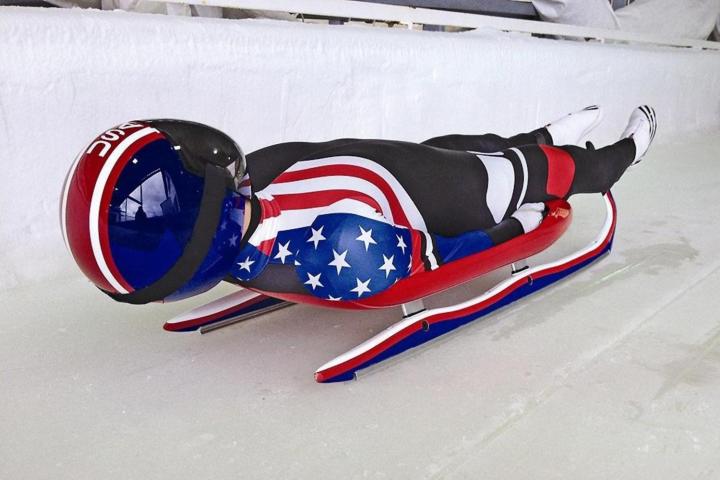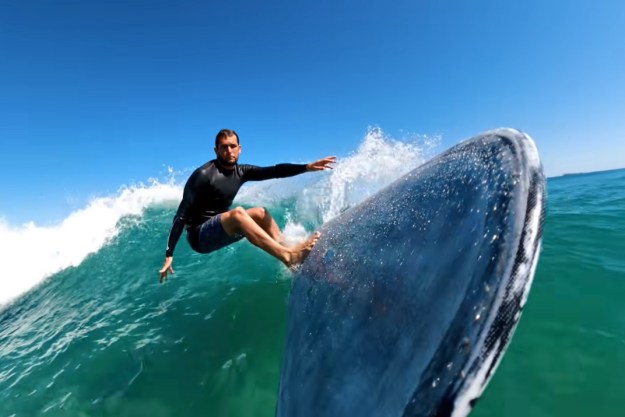
Picture yourself driving down a sheet of ice in a car with no frame, seat belt, brakes or even a steering wheel. Sounds pretty scary, huh? Welcome to the life of a luge competitor. For novices who confuse luge and bobsled, here’s perhaps the biggest difference: Both are extremely difficult, but luge features more potential danger.
To say the least, technique and equipment are exceptionally important in luge, which is why any cutting-edge advantages are welcomed with open arms. For the skinny on the latest advancements fueling the riders repping the U.S. in Sochi, we spoke with three-time Olympic luger and current USA Developmental coach Duncan Kennedy, and former Olympic medalist luger and current Director of Marketing and Sponsorship USA Luge, Gordy Sheer.
GoPro Cameras
For several years, GoPro cameras have maintained a presence within Luge, usually while mounted on a helmet. Sometimes, the goal was to create a video used by an athlete to review his lines or become more familiar with a track. Occasionally, the endgame was nothing more than a fun viral video. But over the last year or so, athletes have begun mounting the cameras underneath a sled while facing backwards, which Kennedy says created a “really interesting view of the sled on the way down the hill.
“It basically opened up a new world for us as far as what was happening dynamically with the sled,” raves Kennedy.
“Virtually every part of the sled has now been digitized and is being tested in the virtual world.”
“In each of the steels, there’s a bow or an arc in the steel front to back, similar to an ice skate. Even though the blade or the steel is nearly three-and-a-half feet, the athlete is only running on about 4 to 6 inches of that blade at a time. So really being able to actually see where it’s running through different parts of the track has been a real eye opener.”
Even acknowledging that the full breadth of knowledge gained from this camera angle remains to be seen, small yet important differences have already been spotted in various lugers. These discoveries in turn prompt adjustments in sled setup, driving style and so on.
“There were a lot of assumptions as to what was going on on the way down the hill, because we do pay attention to the balance point of the sled,” notes Kennedy. “But that’s always been done statically, sitting still. We actually have a mechanism now that measures the balance point quite accurately. So the dynamic view has brought a really valuable, interesting perspective into the real world situation of it. It’s pretty cool.
“You cannot underestimate the kind of subtle but major differences between different athletes. Whether it’s because of their size, their driving style or how they prefer to have the sled set up, you really have to pay attention to the individual aspects.”

In addition to analyzing GoPro footage, luge has made use of Dartfish software, which creates stroboscopic effects so, as Sheer explains, “athletes can see where they drove through an entire curve.” Dartfish also creates an effect where footage of one athlete can be overlaid on top of another athlete. “You can have one of our athletes versus another athlete,” notes Sheer, “and they can drive two different lines during the corner. You can very clearly illustrate the differences by showing those two sleds going down simultaneously.” As a result, a truly tangible comparison can be made between two riders.
Sled design
As Kennedy explains it, there haven’t been an overwhelming number of advancements with luge training itself. Sled design, however, is another story. “What’s happening right now is sort of the beginning of what I see as a bit of a renaissance with our sled technology,” says Kennedy. “In the past, our sleds were basically handmade, one-off sleds. Our old sled builder made very fast sleds, but he couldn’t really make two that were the same. As you can imagine, [with] a sport that’s tied to the 100th of a second and delves into real specific elements, if you can reproduce the sled parts and make them all precise and interchangeable, you already have a good leg up when you continue testing things. You’ve got a baseline of where things are.
“[Today], the kufens, the bridges, the pod that the athlete lays on, virtually every part of the sled has now been digitized and is being tested in the virtual world. To understand the flex patterns and why things are behaving the way they are, on the surface, it probably doesn’t mean a whole lot in some cases. But as we start to build data and continue to test things, then you can say this new set of steels or this new set of kufens has really desirable characteristics. We can go back through the data and see what the changes were and test that. You’re able to reproduce that a little easier.”
Kennedy labels “repeatability” a major plus, and with that quest for consistency, luge has in recent years grown more computer and data driven.
“As I saw the Europeans, the Germans in particular, really stepping up with their precision and their understanding of what was going on with the sleds, we had none of that. We had these racing sleds we were cruising down the hill on. We would test things and try things out. Sometimes they were very fruitful. Sometimes not so much. We wanted to lessen the throwing the darts in the dark and more seeing the bullseye and going after it that way.
“I watch a lot of Formula One and Grand Prix motorcycle racing. To see the approach that motor sports has to all this stuff really got me wanting to move in that direction, because there are quite a few parallels between the sports. It just made sense. The margins are so small right now. We’re fighting for 10ths of a second at the most and 100ths of 1000ths. So every little thing starts to become a factor.”
(Images and videos courtesy of USA Luge and GoPro)
Editors' Recommendations
- The 4 best GoPro alternatives in 2024
- Best GoPro deals: Save on action cameras and accessories
- GoPro Hero 11 Black leak suggests a moderate upgrade
- GoPro keeps recording as parrot steals it from tourists and flies off
- GoPro boosts Hero 10 performance with new firmware and Enduro battery

